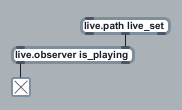Examples

Monitor changes in Live objects
| Name | Type | Opt | Description |
|---|---|---|---|
| property | symbol | opt | Specify a property or child name as argument to live.observer. |
| Name | Description |
|---|---|
| Left inlet | Gets all command messages described below. |
| Right inlet | Gets object id message to select the object to operate upon. In response to the id message, the current value of the property, if a property was already selected, is sent out the left outlet. means no object, i.e. all messages to the left inlet are ignored, which is also the initial state. |
| Name | Description |
|---|---|
| Left outlet | Sends the current value of the selected property of the selected object. The value type depends on the property, as described in the Live Object Model, and may be int, float, symbol, or lists of ids. |
| Right outlet | Sends responses to , , . |
| bla | list-property [symbol] |
Arguments: the name of a list property of the current object Operation: Sends the list of values of given property of the current object. Remark: Not all properties can be set. The types of the properties are given in the Live Object Model.
|
||||||
| property | property [symbol] |
Arguments: the name of a property of the current object Operation: Selects the property to be observed. Outputs the current value to the left outlet if a proper Live object is selected. Remark: Not all properties can be observed. The types of the properties are given in the Live Object Model.
|
||||||
| property | child [symbol] |
Arguments: the name of a child of the current object Operation: Selects the child id to be observed. Outputs the id (or "id 0") to the left outlet if the selected Live object has such a child. Remark: Not all children can be observed.
|
||||||
| property | list-child [symbol] |
Arguments: the name of a child list of the current object Operation: Selects the child list to be observed. Outputs the id list (or nothing) to the left outlet if the selected Live object has such a list child. Remark: Not all child lists can be observed.
|
||||||
| getproperty | Operation: Sends the name of the selected property (or child resp. list-child) out the right outlet.
|
|||||||
| gettype | Operation: Sends the type of currently observed property or child to the right outlet. The types of the properties and children are given in the Live Object Model. For list-children it just sends , w/o further type information.
|
|||||||
| getid | Operation: Sends the id of the currently observed Live object to the right outlet.
|
|||||||
| bang | Operation: Sends current value of selected property of current object to the left outlet. Does nothing if no property or no Live object is selected or if they don't match.
|
|||||||
| id nn | Operation: Sets the current object. The message has the same effect if sent to both the right or the left inlet. For clarity it is suggested to always use the right inlet to supply the object id. - no output - |

| Name | Description |
|---|---|
| Live API Overview | |
| Live Object Model | |
| live.path | Navigate to objects in the Live application |
| live.object | Perform operations on Live objects |
| live.remote~ | Realtime control of device parameters |
| Using the Live API | Creating Devices that use the Live API |
| The LiveAPI JavaScript Object (jsliveapi) | The LiveAPI Object |